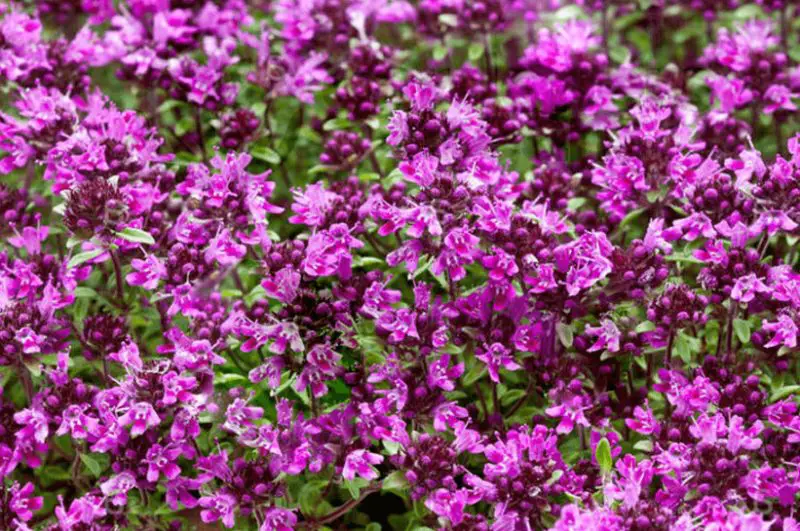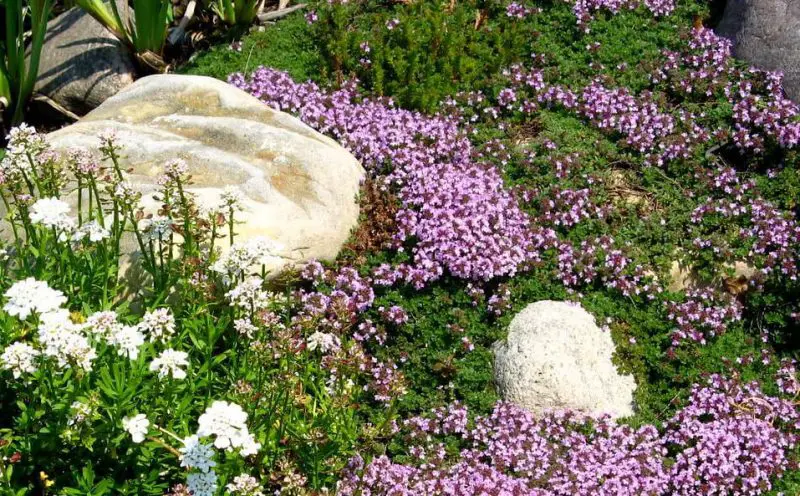Red creeping thyme (Thymus praecox ‘Coccineus’) is considered a living symbol of resilience and beauty in horticulture. Its delicate yet vigorous nature, along with its striking crimson flowers, have made it a favorite choice among landscape enthusiasts.
In this article, we provide detailed information about its preferred growing conditions, maintenance requirements, and breeding techniques.
Whether you are a seasoned gardener looking to improve your landscape or a novice eager to cultivate your green sanctuary, this resource hopes to serve as a roadmap to your success.
About Red Creeping Thyme

Thymus praecox ‘Coccineus,’ scientifically known as red creeping thyme, is a hardy perennial plant belonging to the mint family that is well-known for its versatility and low maintenance needs. This herbaceous marvel, despite its fragile appearance, is a gift for inexperienced gardeners looking for fuss-free foliage because it thrives in a variety of well-drained situations and can even withstand mild foot traffic.
Red creeping thyme, which grows well in Zones 4–9, has evergreen foliage in milder regions that becomes bronze in the fall. Its thick growth pattern acts as a natural weed suppressor and deer repellent, in addition to adding a splash of color with its beautiful summer blossoms.
Beyond being aesthetically pleasing, red creeping thyme attracts butterflies and other useful insects, which helps to promote biodiversity. Its adaptability also extends to landscape, where it can be used in container gardens, rock gardens, walks, and xeriscapes. Adding red creeping thyme to your outdoor space promises a pleasant journey of discovery and appreciation for its outstanding beauty and utility. It also has so many uses and requires so little upkeep.
Guidelines for Growing Red Creeping Thyme
To cultivate thriving red creeping thyme plants, you have several options for starting them. While seeds are available, it’s more practical to acquire nursery plants due to the slow growth of thyme and the limited availability of seeds. Opting for plugs, smaller-sized transplants bought in bulk, is cost-effective, particularly when planting larger quantities. When selecting plants, prioritize those with vibrant foliage and avoid ones with waterlogged roots.
Before planting, choose a sunny location with excellent soil drainage. Amend the soil with compost or sand to lighten heavy clay soils. Spring or fall is the ideal time for planting, avoiding the heat of summer. Depending on the size of your plants and the desired coverage, spacing varies, with closer planting resulting in quicker ground cover.
Prepare the planting area by digging holes slightly wider and deeper than the root balls. Loosen the soil and gently untangle the roots before settling the plants in. Firmly press the soil around the roots and water thoroughly to help establish them. Consistent moisture is crucial, especially for plugs, until they become established.
Propagation of red creeping thyme is straightforward, either by stem cutting or division. Stem cuttings can be rooted in water before potting, while division involves separating a root ball and replanting. Division is best done in spring or early fall, every few seasons, or sooner if plants are spaced closely. With proper care, your red creeping thyme will flourish, adding beauty and biodiversity to your garden.
Red Creeping Thyme Care
Caring for red creeping thyme (Thymus praecox ‘Coccineus’) is relatively straightforward, but attention to a few key factors will ensure its optimal health and beauty in your garden.
Sunlight
Red creeping thyme flourishes under the warmth of the full sun, making it essential to provide it with a minimum of 6 hours of sunlight each day. Although it can tolerate partial shade, its flowering may be less abundant in such conditions. Therefore, to encourage robust growth and a profusion of vibrant blooms, aim to place red creeping thyme in a location where it can bask in the sun’s rays for the majority of the day.
Soil
For red creeping thyme, the soil is paramount. It thrives in well-draining soil, making it imperative to ensure proper drainage. If you’re dealing with heavy or clay-based soils, amending them with organic matter like compost, leaf mold, or soil conditioner can significantly enhance drainage. Aim for a slightly acidic to neutral pH level in the soil, as this provides the ideal growing environment for the plant.
Watering
While red creeping thyme boasts drought tolerance once it’s settled, proper watering during the initial establishment phase is crucial. It’s essential to maintain soil moisture without allowing it to become waterlogged. Deep watering, ensuring the moisture penetrates the soil thoroughly, promotes the development of deep roots, which enhances the plant’s resilience to drought conditions. Striking a balance between consistent moisture and avoiding waterlogging is key to nurturing healthy and robust red creeping thyme plants.
Mulching
Mulching is a beneficial practice for red creeping thyme, offering multiple advantages to its growth and health. By applying a layer of organic mulch around the base of the plants, moisture retention in the soil is improved, reducing the frequency of watering needed. Additionally, the mulch helps to suppress weed growth, keeping the area around the plants tidy and free from competition for resources. Moreover, it serves to regulate soil temperature, providing insulation during temperature fluctuations. However, it’s crucial to avoid mulching directly around the stems to prevent rot and potential damage to the plants.
Fertilizing
Fertilizing red creeping thyme should be approached with moderation. While the plant doesn’t demand much fertilizer, a gentle application of balanced fertilizer in the spring can stimulate healthy growth and abundant flowering. It’s essential to avoid excessive nitrogen, as this can lead to an overgrowth of foliage, potentially overshadowing the flowers.
Pruning
Regular pruning is key to keeping red creeping thyme looking neat and vibrant. By trimming the plant regularly, you encourage it to maintain a compact and tidy appearance while stimulating bushier growth. Additionally, removing spent flowers promptly promotes continuous blooming throughout the season, ensuring a prolonged display of color in your garden. Furthermore, pruning away any dead or leggy stems rejuvenates the plant, allowing for fresh growth and ensuring its long-term health and vigor. With a little attention to pruning, you can keep your red creeping thyme looking lush and beautiful year after year.
Pest and Disease Control
Red creeping thyme generally boasts resilience against pests and diseases, yet occasional issues like powdery mildew or root rot may arise, particularly in humid or overly moist conditions. To mitigate these risks, it’s crucial to maintain good air circulation around the plants and avoid overhead watering, which can exacerbate fungal diseases.
Winter Care
During the winter months, especially in colder climates, providing proper care for red creeping thyme is essential to ensuring its survival and health come springtime. A layer of mulch or straw around the base of the plants can offer insulation, protecting the roots from freezing temperatures and frost damage. However, it’s crucial to avoid covering the foliage with mulch or straw, as this can trap moisture and lead to rot. By focusing on protecting the roots while allowing the foliage to breathe, you can help your red creeping thyme withstand the harsh conditions of winter and thrive once warmer weather returns.
Decorate the garden with red creeping thyme

Designing with red creeping thyme offers an opportunity to create a vibrant and environmentally friendly ground cover, transforming any landscape. Blending taller plants with visually cohesive, low-growing species, akin to the layering of colors and textures in a painting, can yield stunning results. By exploring the versatility of red creeping thyme and understanding its preferences, it may become a cornerstone of your garden projects.
One popular application is in rock gardens, particularly suited for challenging areas like steep slopes and dry conditions. Incorporating boulders and surrounding them with low-maintenance, drought-tolerant perennials such as red creeping thyme adds structure to the landscape while minimizing water and maintenance requirements. Planting red creeping thyme at the forefront and gradually introducing taller species creates a beautiful tiered effect. Consider complementing it with plants like sedum, rudbeckia, Shasta daisy, ornamental grasses, lavender, and mugo pine to enhance the overall aesthetic.






